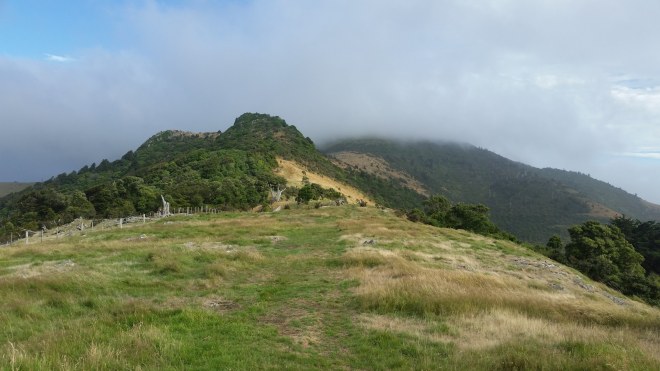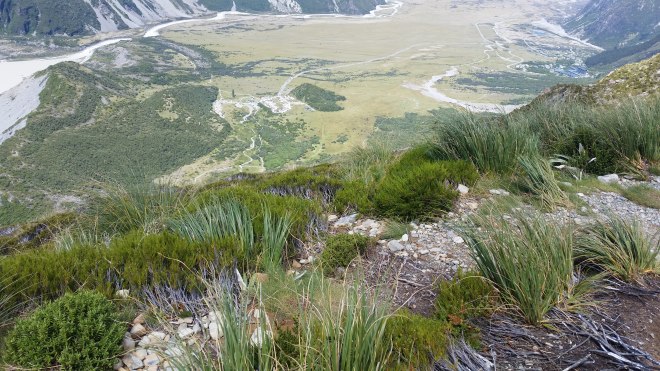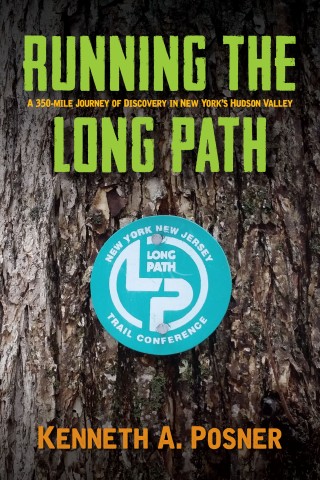Arriving at Christchurch International Airport, I see a young man walking up to the rental car counter in bare feet, and then in town some kids are standing in the school yard or walking home without shoes. To be sure the vast majority of people out on the streets have civilized footwear (or at least flip-flops), but occasional barefooting seems to be a mark of New Zealand’s laid-back culture. And possibly a good omen for my visit, as I’m here for two weeks of hiking in the mountains, some barefoot and some in shoes or sandals depending on conditions.
It’s early February, which means high summer here, so far below the Equator. I stroll through a park in downtown Christchurch admiring a grove of tall, thick pines with scaly orange-brown bark (Pinus pinaster or Martime Pine a sign reads, planted in the 1870s) when a sound catches my ear: zzzzzzick-tika-tika-tika-tika. It’s unmistakably a cicada, but the song is different from those of the Linns Cicadas and Dog-Day Cicadas back home in New York. Some online research suggests this is the Chorus Cicada (Amphipsalta zelandica), which by some accounts grows as large as your palm. Then why can’t I see one?
I’m hunting through the park, following a tree-lined path, pausing frequently to peer up into the canopy, running my eyes along the arching branches, trying to zero in on the singers, whose music is reverberating all around – it’s quite a cacophany. The screeching sound is produced by a special organ called a tymbal, I read online, and sometimes there’s a loud clicking sound when the insect taps its wings against the bark.
After craning upwards until my neck hurts, I finally spot something on a tree trunk right in front of my face. It’s not as big as my palm, only an inch or two long – but what a handsome individual! Busy at work calling for a mate, wings flashing in the sun as he taps them against the bark.

My first hike in New Zealand is to be on the Banks Peninsula, about an hour east of Christchurch, and on the way I make another important discovery: even a humble roadside café makes an excellent cappuccino, with high-quality espresso coffee, perfect foamy creamy milk, and a sprinkle of chocolate (unless you want cinnamon). The peninsula consists of a ring of hills encircling a bay, the eroded remnants of two shield volcanoes estimated 8-11 million years old. The slopes are largely grassland, green and gold and reminiscent of California’s coastal hills. Here and there are patches of dark green, but in this part of New Zealand, less than 2% of the surface area is forested, as the land was long ago cleared for pasture and turned over to cows and sheep.

I’m soon hiking along a rocky path through a patch of southern beech (Northofagus, distant cousins of the American Beech that fills New York’s forests) and then the trail passes a massive Totara tree (Podocarpus totara), a member of the podocarp family (southern hemisphere evergreens), its huge trunk probably 6 or 8 feet in diameter and covered in long stringy bark. There are strange-looking ferns in the forest with hairy brown stems and another kind growing in rings with distinctive fertile fronds that look like centipedes (possibly Crown Ferns). A short tree with peeling orange-brown park is called Tree Fuchsia and is related to the popular flowers.

The trail emerges onto a grassy ridge. This is much more pleasant on the feet than the rocky trail through the forest (since I’m in barefoot hiking mode). However, after crossing over a fence, I encounter a group of animals staring at me. The sheep seem suspicious and keep their distance, while the cows stand their ground, turning their heads just enough to keep an eye on me. I respect their personal space and opt to maneuver off trail for a short distance to get around them.
There are familiar flowers sprouting here, like Burdock and Yarrow, which are non-native invasives in New Zealand, as well as native species like golden speargrass (Aciphylla aurea) with bright yellow flower spikes.

I pass a rocky summit with an antenna installation and persevere toward a distant saddle, hoping to reach Mt. Herbert, the highest point on the Banks Peninsula. The trail markers lead me through tall grass tussocks and into a misty forest of scrubby trees with beard lichen dangling from their branches, but the summit seems no closer, and then the trail heads down the shoulder of the mountain into dense fog. Checking the map, it seems I’ve miscalculated: Mt. Herbert is several miles away and well out of reach. And clouds have moved in and the wind is picking up.


I retrace my steps across the saddle, but now the wind is whipping across the exposed ridge, sending long waves flowing through the grasses. I pull on a goretex jacket to keep from getting chilled and stagger forward, buffeted about, struggling to keep moving in a straight line.

These winds are the aftermath of a cyclone that passed through the Tasman Sea, I learn a little while later, once down in the seaside town of Akora. Gusts are still tussling with the trees, and an umbrella canopy gets knocked down in one of the sidewalk cafes, but the clouds are gone, the sun feels strong down here, and the water in the bay gleams faint green.

I walk under a large, splendid Pohutukawa Tree (Metrosideros excelsa), a member of the myrtle family, and nicknamed the “New Zealand Christmas Tree,” and examine the clusters of red blossoms.


The next day finds me north of Christchurch in the Oxford Forest Conservation Area, slogging through a forest of Black Beech. It’s cloudy, cool, and raining steadily, and I’m dressed in goretex and wool, tops and bottoms. Black beech (Fuscospora solandri) gets its name from a coal-colored sooty mold fungus that thickly covers the bark and spreads along the ground at the foot of the tree Apparently a scale insect digs into the bark, sucks up sap, and excretes droplets of a sweet liquid (these sugary excretions are called “honeydew”). Honeydew not only feeds the mold but also attracts birds and insects including a frenzy of wasps that dart about on the trunks and branches. The department of conservation website warns about the wasps, whose population peaks in February, and advises carrying antihistamine cream as a precaution. But the wasps don’t seem interested in me, and nor should they be as I’m not carrying anything sweet. On my part, I’m careful not to interfere with their activities.
The trail to Mt. Oxford crosses a rushing stream, and feeling risk-averse (suppose with all the rain the waters rise further?), I immediately change the mission and instead turn left on the trail to Ryde Falls, which turns out to be an impressive multi-tiered waterfall pouring from a cleft in a narrow gorge hidden in one of the mountain’s steep folds. It’s been a ten-mile roundtrip in bare feet, in steady rain, and not a single wasp sting – even without Mt. Oxford, the mission is a success.

The next day it’s time to head south. After three or four hours driving across vast agricultural plains, I pull up along the southern shore of Lake Pukaki, a twenty-mile long glacial lake lying at the base of snow-capped mountains. The water is shining a remarkable brilliant turquoise, apparently the result of a fine silt called “glacial flour” that’s suspended in the water, produced by glaciers grinding away at the mountain bedrock. It’s an astonishing sight.

A small tourist village lies at the far end of Lake Pukaki, and this is my planned stop for the evening. It’s supposed to be a rest day, but I can’t resist a short hike along a trail that leads up into the mountains. Once it turns upward, the trail is lined with steps fashioned from wooden frames and filled with dirt and gravel. After climbing 3,000 feet, the path reaches a small pond (a glacial “tarn”) overlooking the valley. From here, the trail continues upwards another 1,000 feet to a mountain hut, although now the steps are gone and instead it’s a twisting path through sharp rocks, tumbled boulders, and loose dirt and scree.
Eventually I arrive on the shoulder of a ridge and find a pile of rocks to perch upon and survey the surroundings. To the north looms the peak of Mt. Cook (called Aoraki in the native Maori language), and on either side jagged ridges of black and brown rock rise into the sky, gray talus fields slope down into the valleys, and huge white blocks of ice and snow cling to the upper reaches. Down below in the valley, the meltwater empties into a cloudy gray-green lake thick with glacial flour and then wends out across the plains toward Lake Pukaki a few miles to the east.



The 4,000-foot descent is painful on the feet (since I’m wearing thin sandals). Knees are soon aching, too, and ominously a sore ankle tendon begins to complain. The next day is another long drive south, to Te Anau, where the Kepler Track awaits.

Running the Long Path is available on Amazon (Click on the image to check it out)
Wow! Thanks for sharing!
Tony
LikeLiked by 1 person
[…] for the long drive back to Christchurch. Half-way there I pass Lake Pukaki, shimmering an extraordinary shade of turquoise, a phantasmagorical scene straight out of a fantasy […]
LikeLike
[…] which means there are twenty to go. That would be a lot for a full month, but with a trip to New Zealand scheduled for the first half of February, those twenty peaks will need to be climbed when I […]
LikeLike
[…] in different shades of blue — with some of the magical turquoise color I’d seen in the glacial lakes of New Zealand. In the distance, the western flanks of the mountains of the Devil’s Path, frosted blue and […]
LikeLike